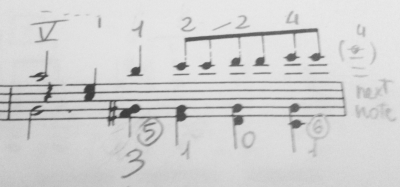On Fingerings & Breakthroughs

Choosing the fingering for a passage of music is an extremely personal process—what comes off easy for one player might prove a stumbling block for another. Granted, there are some general guidelines and principles that can be applied to everyone as a starting point, but that still leaves a critical amount of discretion to the individual player, who usually ends up choosing fingerings in accordance to the bias in his or her hands.
My personal preference is for easy fingerings. Somewhat along the lines of the Buddhist mantra “pain is inevitable, but suffering is optional,” I find playing classical guitar to be a challenging enough endeavor without the need to make it even harder. If there’s a way to employ open strings for shifting, or to arrange a chord in a more “ergonomical” position, I always consider these possibilities very carefully. On the other hand the musicality of any given fingering comes into play quite heavily as well. Is it musically acceptable to use an open string to help with a shift in a given passage? More often than not, I’ve found that the easier fingering is also the more musical one—presumably because I can play it in a more relaxed, flowing fashion.
Sometimes, a slight adjustment to your plucking hand can also come to the rescue. An old assumption is that, by moving fingerings “upstairs” to a thicker string/further up on the fretboard, the player would gain in tone color and expressivity. A good right hand exercise is to try and homogenize your sound as much as possible, so that if needed you could “smuggle” a note or passage on the high E string as sounding fuller and darker, as if you had played it on the B. This way you might end up unlocking an easier way to finger an entire phrase.
A Brief Case Study
Perhaps the most important concept regarding fingerings is that they should never be considered engraved in stone. Case in point: Earlier this afternoon I was practicing a couple of passages from the Villa-Lobos Concerto that have been bothering me for months. Sure, I could play them, but as I approached these measures I kept feeling as if I was putting my success in the hands of some fickle deity. Today I decided to backtrack a bit and reconsider what I had chosen as the “best” fingering for one of the phrases.

It occured to me that the fingering in question had two significant problems:
- To fret the F#, I am moving from fifth to fourth position for a split second. This shift is against the direction of the phrase, since I have to hit a high C, D, and E immediately after. That’s not a very economical approach, to put it mildly.
- Because of this “mini-shift” to fourth position, I was fretting the high C with my pinky, then basically sliding it up all the way to a high G in the space of a few (and rapid!) beats. I felt this “sequential shifting” was likely the culprit of my difficulties with the passage (especially considering I was lifting the pinky a bit to avoid sounding a series of portamentos)
Within a couple of minutes I had already found a viable substitute. Fingering #2 is better in pretty much all aspects: I am shifting in the direction of the phrase, and I am giving my pinky a modicum of relief by using 2 to fret the high D. Although it’s early to tell, I feel much more confident when practicing the phrase—a feeling that helps making the ensuing measures easier to pull off as well.

Some readers may be wondering why I didn’t choose the best fingering in the first place. The honest answer is that I thought the first fingering was just fine, and I just needed to practice it more. The lesson in this? Sometimes we’re the ones building the walls that we end up hitting. If you feel stuck with a phrase or passage, try breaking it down in its essential parts and reconsidering the way you approach it. You might end up slapping your forehead and wondering why on earth you didn’t think of this other solution sooner.

Janice Pena
An excellent article. For the longest time I thought the fingerings written down were indeed engraved in stone and had to be done that way. My teacher has really helped me realize that this is not the case, which has really freed up my playing.
Drew
This is so true.
I have been using one of the WG Leavitt books for my students learning to read for the first time, but I am constantly telling them (to the chagrin of a few of my colleagues) that not everything he writes in there is best for everyone…sometimes your fingers can pull of something much better the “wrong way”.
IMO,if it sounds good, and you can do it consistently, do it.